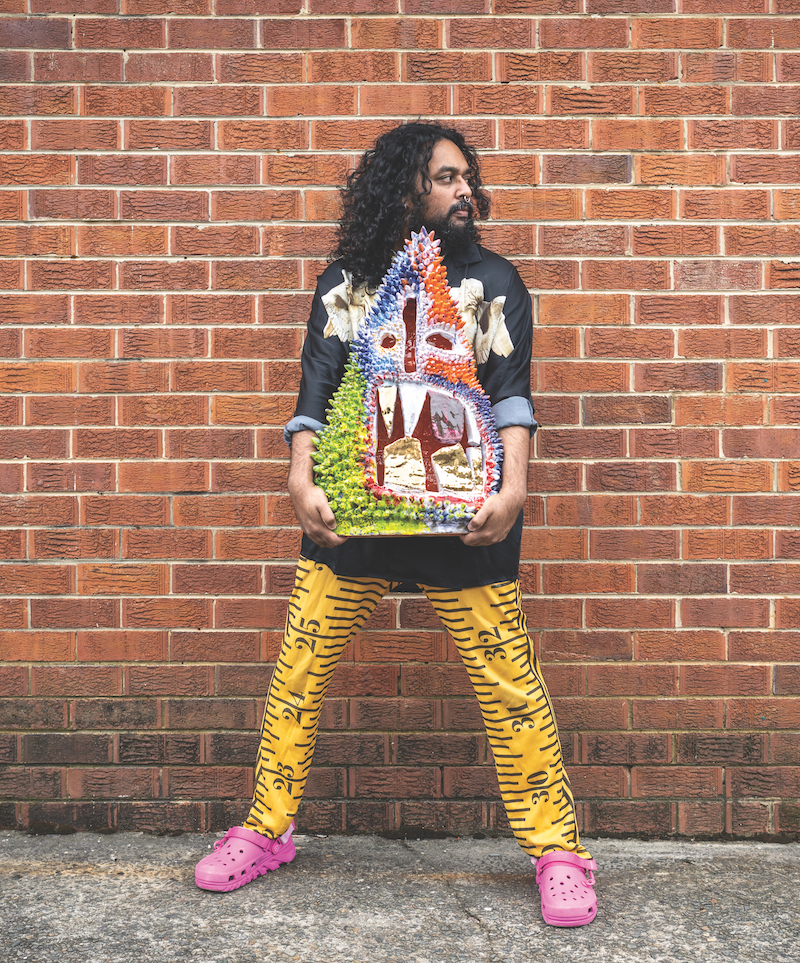“I showed the new book to my friend and they said ‘wow it’s like you’re 80 years old’,” Ramesh Mario Nithiyendran tells me, laughing, before quickly adding, “Just in terms of the quantity of work.” Nithiyendran has been busy. His new monograph, Ramesh, 2022, testifies to this very fact, tracking eight years of the artist’s life, across more than 500 artworks. It is strange talking to Nithiyendran about his work, because his friend is exactly right: it feels like I should be speaking with an octogenarian, presiding over a lifetime of achievement, rather than an artist who has barely entered his 30s.
The very form of an artist monograph suggests certain conventions. In a practical sense, these kinds of books inventory an artist’s work and produce an archive of sorts – they collate artworks and manufacture a chronology for the creative chaos. In a slightly less obvious yet related manner, the artist’s book is a way of narrativizing their oeuvre – a way of telling a neat story about the inevitable mess of life. These are the unspoken orthodoxies of the artist book format. Of course, Ramesh does all of these things to a certain extent; yet the book also seems to push back against these same regimes of order.
“This sounds kind of cliché, but I see the book a little bit like an artwork,” Nithiyendran says. “I kind of wanted to keep it fresh and keep it alive.” While his artworks are permanently frozen within its printed pages, they almost seem to resist this state of dormancy. Just as his anthropomorphic ceramics – for which Nithiyendran is well known – always seem to teeter on the edge of action and expression, so too the pages of his book feel inexplicably alive. Each chapter is rendered in a different font, with handwritten notes and hand-painted images amplifying the immediacy of the text. Unsurprisingly, there are no blank pages to be found in the book – no gaps or breaks between the works, where one might rest their eyes. Rest is for later. This book is an exercise in complete and furious immersion.
Something that I often notice when interviewing artists is the battle for control. Perhaps, that description is too dramatic. However, there is usually some sense of an artist wanting to define not only their narrative, but also the stories that we tell and re-tell about their artworks. Of course, it’s completely understandable. You and I may spend a few seconds, minutes, or even hours in front of their work in a gallery, while they have spent weeks, months, or years standing in the same place. How could they not want to control the narrative?
Against this backdrop, Nithiyendran’s far freer attitude is striking. “I think one of the worst things you can be as an artist is uptight,” he says. “Isn’t the beauty of visual culture that you actually have to release some autonomy over how the work is being read and consumed?” This is more than just loose rhetoric. Nithiyendran explains how his 70-piece work Avatar Towers, 2020, which was recently acquired by the Art Gallery of New South Wales, Sydney will be reconfigured in a forthcoming exhibition to be held in the museum’s new Sydney Modern space. “With complicated large scale works like this, if it has very specific requirements of display, it just won’t get displayed very often,” Nithiyendran explains. “There’s like 70 sculptures in it and I don’t want it to just be in storage for the rest of its life – so there needs to be some possibility for it to have different iterations.”
There is something strikingly practical about this statement, yet equally striking is the sense of artistic surrender contained within it. As we speak, however, it becomes clear that a loss of control is not what Nithiyendran fears. “I don’t have any sentimental attachment towards any works really,” he observes. “I think one of my fears with death is just still having all these ideas that don’t come to fruition.”
When we talk, Nithiyendran is in the throes of work and is just about to fly to Melbourne. He has works going to Frieze London, pieces soon to be shown in a group show at the Sharjah Art Museum, UAE, and a large bronze commissioned for the entrance of Sydney Contemporary art fair. This is all off the back of solo exhibitions at his representative galleries Jhaveri Contemporary, Mumbai in 2022 and Sullivan+Strumpf, Sydney in 2021 and a large commission for Vivid 2022, Sydney. Fruition does not seem to be the issue. Yet it is interesting to hear him account for some of the unseen forces that propel his ever-expanding oeuvre forward.
Rather than just describe his bronze Sydney Contemporary sculpture, he texts me some sketches of the commission: a drawing of a multilimbed body and a double-sided head, split down its centre, stares out of my phone screen. “It is probably the most complicated bronze I’ve ever made,” Nithiyendran muses, before launching into a detailed description of the work. He tells me about the specific patina he is hoping to achieve, the physicality of the sculpture, its internal proportions, as well as its planned placement and elevation, before he pauses and wickedly adds, “there is a slight chance that it just might not look like that at all.” It is the perfect reflection of the artist, whose work can barely be contained in a book, let alone a conversation.
Featured image: Ramesh Mario Nithiyendran with his work Multi-coloured Spiky Head, 2022. Photos: Mark Pokorny. courtesy: the artist and Sullivan+Strumpf, Sydney.

